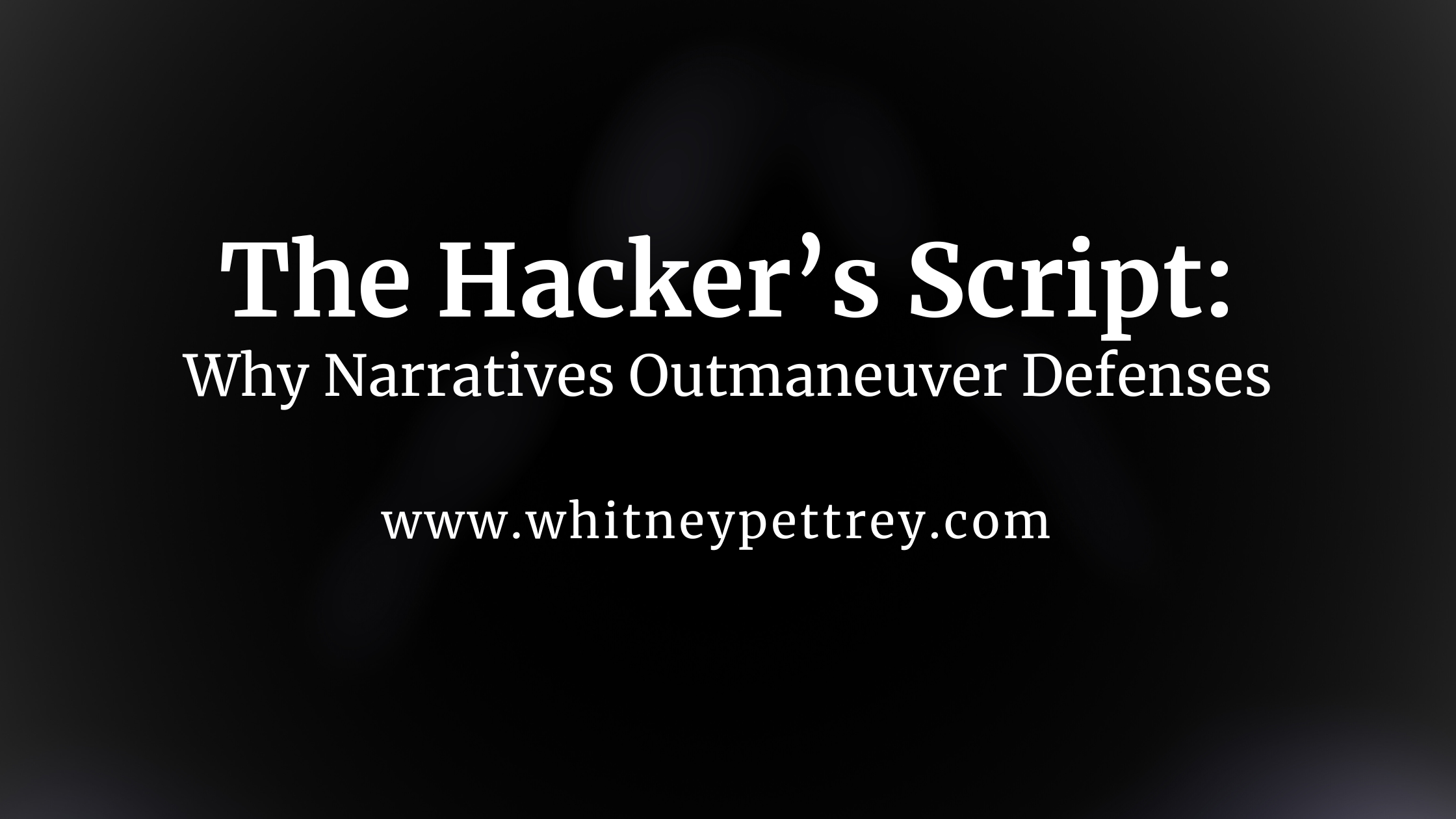Hackers don’t just infiltrate systems; they orchestrate narratives that exploit our trust, emotions, and sense of control. Every breach, exploit, and social engineering campaign follows a carefully crafted story arc designed to achieve a desired outcome. Their success lies not merely in technical prowess but in their mastery of narrative design—creating scripts that manipulate and deceive with devastating precision.
What makes their approach so powerful is its intentionality. Hackers understand that humans are wired for narratives. They know how to construct scenarios that bypass logic and speak directly to our instincts. This is where defenders often falter, relying on technical jargon and procedural checklists that fail to inspire or engage. To outmaneuver adversaries, defenders must embrace the art of storytelling, using it to align teams, build resilience, and outthink attackers. This is not just about stopping hackers—it’s about rewriting the narrative entirely.
Three Strategies to Reclaim the Narrative
1. Adaptive Training: Use immersive simulations that mimic real-world attacks to teach employees how to recognize and respond to manipulation tactics.
2. Proactive Storytelling: Frame cybersecurity policies as a shared mission where every individual has a role, transforming them from passive participants into engaged defenders.
3. Strategic Decoys: Deploy deception technologies like honeypots to mislead attackers and gather intelligence, flipping the script on adversaries.
Act One: The Setup—Crafting Context That Matters
Hackers begin with the foundation of every great story: understanding their audience. They don’t just analyze systems; they study human behavior, corporate culture, and communication patterns to craft narratives that feel believable and unavoidable.
Consider the 2020 Twitter breach. Hackers exploited trust placed in a help desk, pretending to be internal employees. They used urgency and authority to weave a narrative that convinced Twitter staff to grant access to high-profile accounts. This wasn’t a brute force attack—it was psychological manipulation, rooted in a deep understanding of how trust operates within organizations.
In contrast, defenders often fail to connect with their audience. Security policies are distributed as lifeless directives, detached from the realities employees face daily. What if defenders reimagined this phase? By framing security as a shared mission—with employees as protagonists protecting vital assets—organizations can create a culture of vigilance. Everyone becomes a character in the story, transforming security from a burden into an empowering narrative.
Act Two: The Heist—Executing the Plot
Hackers execute their plans with the precision of a heist movie. Social engineering campaigns, for instance, are masterclasses in emotional manipulation. Each phishing email is an invitation into a carefully constructed story designed to elicit a specific response: urgency, fear, greed, or curiosity.
Take the SolarWinds supply chain attack. Hackers embedded malicious code into a trusted software update, turning a mundane process into a global catastrophe. The brilliance of this attack lay in its subtlety. By leveraging the trust organizations place in their vendors, the hackers constructed a narrative that bypassed even the most advanced defenses.
Defenders can learn from this precision. Instead of generic training programs, organizations could design immersive simulations that mimic real-world attacks. Picture an interactive phishing exercise where employees navigate a storyline filled with emotional hooks, learning to recognize manipulation in real-time. This isn’t just about identifying threats—it’s about building empathy for the adversary’s tactics, turning employees into active participants in the defense narrative.
Act Three: The Twist—Staying Ahead of the Adversary
Every great story has a twist, and hackers excel at introducing the unexpected. They use lateral movement, decoy systems, and hidden payloads to complicate the narrative, ensuring defenders remain disoriented.
The NotPetya ransomware attack is a striking example. Initially perceived as a ransomware campaign, it became clear that its true intent was destruction. The ransom mechanism was a ruse; there was no way to recover the encrypted data. This twist reshaped the entire narrative, leaving organizations unprepared for the scale of disruption.
For defenders, adaptability is key. Static defenses and predictable protocols make organizations easy targets. By adopting dynamic strategies like deception technology and real-time adaptive responses, defenders can introduce their own twists. Tools such as honeypots can mislead attackers into chasing false narratives, gathering intelligence that strengthens the organization’s defenses. In this way, defenders take control of the story, forcing attackers to react.
Act Four: The Resolution—Owning the Ending
Hackers understand the importance of a strong conclusion. Whether it’s exfiltrating sensitive data, installing backdoors, or creating chaos, their endings are intentional and impactful. These resolutions linger in the minds of their victims and serve as stark reminders of vulnerabilities.
Defenders, however, often miss this opportunity. Incident response reports are filled with technical jargon, devoid of the human element that makes stories resonate. But every breach is a chance to craft a powerful narrative of resilience and recovery.
Consider a financial institution that withstands a coordinated DDoS attack. Instead of producing a sterile report, they could frame the incident as a story of triumph: quick detection, collaboration under pressure, and successful restoration of services. Highlighting these victories reframes the narrative from one of vulnerability to one of strength and resilience. This approach not only restores confidence but also motivates teams to stay vigilant.
The Moral of the Story—Reclaiming the Narrative
Hackers succeed because they understand the timeless power of narrative. They use these scripts to manipulate perception, influence decisions, and achieve their goals. Defenders, too, can harness this power. By crafting stories that inspire, engage, and adapt, defenders can transform security from a technical discipline into a shared mission.
The ultimate twist? Narrative design isn’t just a hacker’s tool—it’s a universal skill that can redefine how we approach defense. When defenders master the art of narrative, they don’t just respond to threats—they set the stage for a new era of innovation and resilience.
The only way to outmaneuver the hacker’s script is to write a more compelling one—one that adapts, evolves, and turns every attack into a story of resilience.
